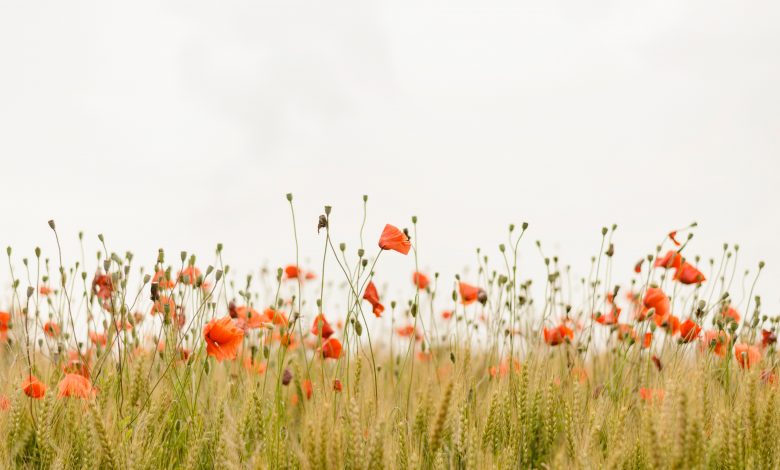Flowers, Plants, and Their Meanings

Floriography, or “language of flowers,” is a method of coded communication that dates back to the Victorian era, perhaps earlier. It’s been used around the world as a way to say “I love you” or symbolize other sentiments. But it wasn’t just the species doing the talking either: colors of flowers mean different things; whether the bouquet sits in your right-hand means something while having it in your left means another; presenting a flower upside-down could mean something completely different.
Plants have been used to cure ailments (hemp), plucked for good luck (clover), and to ward off evil spirits (sage) since the early stages of human evolution. Cultures all around the world have done this, though England’s interpretations are most common. During the Victorian Era, sending messages with flowers and other plants became a social ritual.
The compiled list below is one version of a generally agreed-upon list of flowers and what they mean. Over the past 200 years, various dictionaries have been published around the world describing what each flower means depending on the author, country, or time period.

The Language of Flowers
Floriography was used in decades past as a way to communicate messages that were not appropriate to openly share. The flower itself is only one piece to the puzzle, like a word in a sentence. The combination of flowers used, the arrangement, the presentation, and the receiving of plants can all be interpreted in different ways. If flowers were given in the right hand, this meant “yes” to a question asked. If they were given with the left, it meant the answer was “no.” A flower or flowers handed upside-down could be used to communicate the opposite message of what the plant traditionally means. Also, if a bouquet is tied with a ribbon to the left, it signified importance to the giver, whereas a bow to the right was meant to signify sentiment to the receiver.

During those days it was inappropriate to speak about certain topics in front of those from another social class; likewise, many topics within social order were taboo. Relationship talk was a no-go, as was flirting. A variety of bouquet called a tussie-mussie was used as a way to block unpleasant odors and by suitors seeking their lady’s hand. Tussie-mussies, or called nosegays, are a combination of herbs with a central flower. Less traditionally though, they are filled with small blossoms wrapped in a paper cone. If a suitor presented one of these arrangements to a lady and she held it at her heart, it meant that she accepted his advances. If the tussie-mussie was held pointing down, the woman was rejecting the suitor.
To help maneuver the secretive language of the flowers, floral dictionaries started being published in the Victorian Era. Within these pages were meanings derived from native legends, myths, and fables. Flowers and their meanings have changed over time, but this list is presented by the Farmer’s Almanac, which has been centered around plants since 1818.
Meanings of Plants
Aloe – Aloe vera was known by the Egyptians as the plant of immortality. It’s said that both Cleopatra and Nofretete used it as part of their beauty routines. It symbolizes healing, protection, and affection.
Amaryllis – Pride
Anemone – Forsaken
Angelica – Inspiration
Apple blossom – Preference
Arborvitae – Unchanging friendship
Aster– Love, daintiness
Bachelor’s button – Single blessedness
Basil – Good wishes
Bay – Glory
Begonia – Beware
Bittersweet – Truth
Black-eyed Susan – Justice
Bluebell – Humility, kindness
Camellia – In China, the camellia represents the union of lovers, where the petals represent women and the leafy base holding the petals represents men.
– Pink – Longing For You
– Red – You’re a Flame in My Heart
– White – Adoration
Candytuft – Indifference
Carnation – Carnations have taken on many meanings over time. The Farmer’s Almanac writes that, in general, they are a sign for women and love. Folklore says that carnations grew from the tears of Mother Mary as she watched Jesus carry the cross. However, fast-forward to World War II, white carnations were worn in the Netherlands as a sign of resistance to the war.
– Red – My Heart Aches, admiration
– White – Innocence, pure love, women’s good luck gift
– Pink – I’ll never forget you
– Purple – Capriciousness
– Yellow – Disdain, disappointment, rejection
Chamomile – Patience
Chives – Usefulness
Chrysanthemum – Cheerfulness
Clematis – Artifice (cunning), poverty
Clover, white – Think of me
Clover, four-leaf – Luck, happiness
Columbine – Anxiousness, foolishness
Coreopsis – Always cheerful
Coriander – Hidden worth
Crocus – Spring, youthful cheer
Cumin – Fidelity
Cyclamen – Resignation, good-bye
Daffodil – Regard
Dahli – Dignity, pomp
Daisy – Innocence, hope
Dill – Power against evil
Edelweiss – Courage, devotion
Fennel – Flattery
Fern – Sincerity, humility, magic, bonds of love
Forget-me-not – True love memories
Gardenia – Secret love
Geranium, oak-leaved – True friendship
Gladiolus – Remembrance
Goldenrod – Encouragement, good fortune
Heliotrope – Eternal love
Hibiscus – Delicate beauty
Holly – Foresight, defense
Hollyhock – Ambition
Honeysuckle – Bonds of love
Horehound – Health
Hyacinth – In Victorian times, this flower meant games/sport, playfulness, rashness. Stemming from Greek mythology, the name hyacinth comes from the character Hyakinthos. Sun god Apollo and Zephyr, the god of the west wind, were in competition for Hyakinthos’ affection when accident struck. A jealous Zephyr blew wind at Apollo while he was teaching Hyakinthos how to throw a discus, but it instead reversed the direction of the disc, killing Hyakinthos. A new flower bloomed from his blood, and Apollo called them hyacinth in honor of his beloved.
– Blue – Constancy of love
– Purple – Sorrow, forgiveness, regret
Yellow – Jealousy
White – Loveliness, prayers for someone
Hydrangea – Gratitude for being understood, frigidity and heartlessness
Hyssop – Sacrifice, cleanliness
Iris – A message
Ivy – Friendship, continuity
Jasmine, white – Sweet love, amiability
Lady’s-mantle – Comforting
Lavender – Devotion, virtue
Lemon balm – Sympathy
Lilac – Joy of youth
Calla Lily – Beauty
Daylily – Chinese emblem for mother
Lily-of-the-valley – Sweetness, purity
Lotus Flower – Purity, enlightenment, self-regeneration, rebirth
Magnolia – Love of nature
Marigold – Despair, grief, jealousy
Marjoram – Joy and happiness
Mint – Virtue
Morning glory – Affection
Myrtle – Good luck, love in a marriage
Nasturtium – Patriotism
Oak – Strength
Oregano – Substance
Pansy – Thoughts
Parsley – Festivity
Peony – Bashful, happy life
Pine – Humility
Poppy – Consolation
Rhododendron – Danger, flee
Roses – The rose, of course, symbolizes love and desire. However, that’s just the red and orange varieties. Other colors symbolize other sentiments:
– White – purity, innocence, reverence, new beginnings, a fresh start.
– Red – Love
– Dark crimson – Mourning
– Pink – Grace, happiness, gentleness
– Yellow – Jealousy, infidelity
– Orange – Desire and enthusiasm
– Lavender – Love at first sight
– Coral -Fiendship, modesty, sympathy
Rosemary – Remembrance
Rue – Grace, clear vision
Sage – Wisdom, immortality
Salvia – Salvia divinorum means “diviner’s sage.” It was used in Mesoamerica as a way to generate the divine within the peoples.
Blue – I think of you
Red – Forever mine
Savory Spice – Interest
Snapdragon – Deception, graciousness
Sorrel – Affection
Southernwood – Constancy, jest
Sunflower – Adoration, false riches
Sweet pea – Pleasures
Sweet William – Gallantry
Sweet woodruff – Humility
Tansy – Hostile thoughts
Tarragon – Lasting interest
Thyme – Courage, strength

Tulip – The word “tulip” comes from the Persian word for turban. Some believe this was a European mistake; tulips were significant in Persian and Turkish culture, and many wore them tucked into their headdresses. Tulips, like many flowers, are a symbol of love. The tulip, though, slightly different, means perfect love. According to Turkish and Persian legends, Prince Farhad fell in love with Shirin, who was ultimately murdered. Heart-broken, Farhad rode his horse off a cliff. Tulips grew from Farhad’s blood. But there are several versions of this legend. In another version (similar to the Turkish version of Romeo and Juliet), Shirin is a princess forbidden to marry Farhad, a commoner. He must prove his love for Shirin to her father, but upon completion of his task, Farhad is told Shirin is dead. He is so distraught he kills himself. When Shirin discovered what has happened, she goes to Farhad’s body and, in turn, kills herself. Red tulips, according to the myth, grew in their blood.
– Red – Passion, declaration of love
– Yellow – Sunshine in your smile
Valerian – Readiness
Violet – Loyalty, devotion, faithfulness, modesty
Wallflower – Faithfulness in adversity
Willow – Sadness
Yarrow – Everlasting love
Zinnia – Thoughts of absent friends
Other Meanings
In America, each state has its own state flower.
- Alabama – Camellia, Oak-leaf hydrangea
- Alaska – Alpine Forget-me-not
- Arizona – Saguaro Cactus Blossom
- Arkansas – Apple Blossom
- California – California Poppy
- Colorado – Rocky Mountain Columbine
- Connecticut – Mountain Laurel
- Delaware – Peach Blossom
- Florida – Orange Blossom, coreopsis
- Georgia – Cherokee Rose
- Georgia – Native Azalea
- Hawaii– Pua Aloalo, red pua lehua, ‘Ohi’a Lehua, lokelani, pua ‘llima, hinahina, pua kukui,
- Idaho – Syringa
- Illinois – Violet
- Indiana- Peony
- Iowa – Wild Rose
- Kansas – Wild Native Sunflower
- Kentucky – Goldenrod
- Louisiana- Louisiana Iris, magnolia
- Maine – White pine cone, tassel
- Maryland – Black-Eyed Susan
- Massachusetts – Mayflower
- Michigan – Apple Blossom
- Michigan – Dwarf Lake Iris
- Minnesota – Pink and White Lady Slipper
- Mississippi – Coreopsis
- Mississippi – Magnolia
- Missouri – White Hawthorn Blossom
- Montana – Bitterroot
- Nebraska – Goldenrod
- Nevada – Sagebrush
- New Hampshire – Pink Lady’s Slipper
- New Hampshire – Purple Lilac
- New Jersey – Violet
- New Mexico – Yucca
- New York – Rose, lilac
- North Carolina – Dogwood, Carolina Lily
- North Dakota- Wild Prairie Rose
- Ohio- White Trillium
- Ohio – Red Carnation
- Oklahoma – Mistletoe, Oklahoma Rose, Indian blanket wildflower
- Oregon- Oregon Grape
- Pennsylvania – Mountain Laurel, Penngift Crownvetch
- Rhode Island – Violet
- South Carolina- Yellow Jessamine
- South Carolina – Goldenrod
- South Dakota- American Pasque
- Tennessee- Passion Flower
- Tennessee- Iris, Tennessee Coneflower
- Texas – Ennis, Nymphaea Texas Dawn waterlily, bluebonnet, maroon bluebonnet
- Utah – Sego Lily
- Vermont – Red Clover
- Virginia – American Dogwood
- Washington- Coast Rhododendron
- West Virginia – Rhododendron
- Wisconsin- Wood Violet
- Wyoming – Indian Paintbrush
Similarly, each month has a flower to represent it.
- January – Carnation
- February – Iris and Violet
- March – Daffodil
- April – Daisy and sweet pea
- May – Lily-of-the-valley
- June – Rose
- July – Larkspur and waterlily
- August – Glads
- September – Aster
- October – Marigold
- November – Mum
- December – Narcissus, holly, and poinsettias
Sources
Catherine Boeckmann (2019). “Flower Meanings: The Language of Flowers” The Farmer’s Almanac
FTD Fresh (2016). “Camellia Meaning and Symbolism” FTD By Design
FTD Fresh (2016). “Carnation Meaning and Symbolism” FTD By Design
FTD Fresh (2016). “Tulip Meaning and Symbolism” FTD By Design
Melissa Breyer (2015). “The language of flowers, herbs and trees: 71 plants and their meanings.” Treehugger
FlowerMeaning.com (2019). “The Hyacinth Flower: It’s Symbolism & Meaning”
ProFlowers (2016). “Floriography: The Language of Flowers in the Victorian Era”
Lynn Coulter. “What’s Your Birth Month Flower?” HGTV



